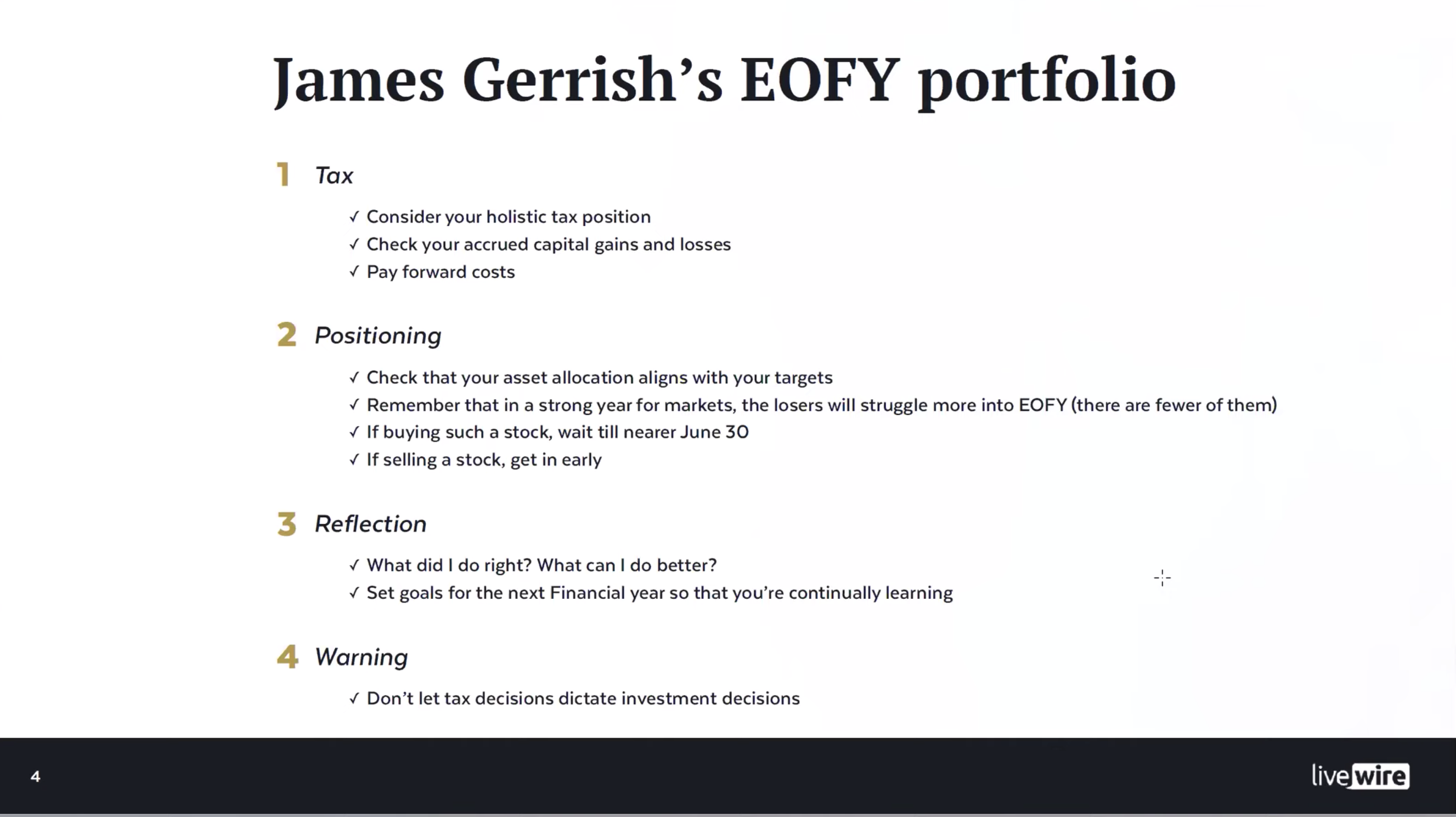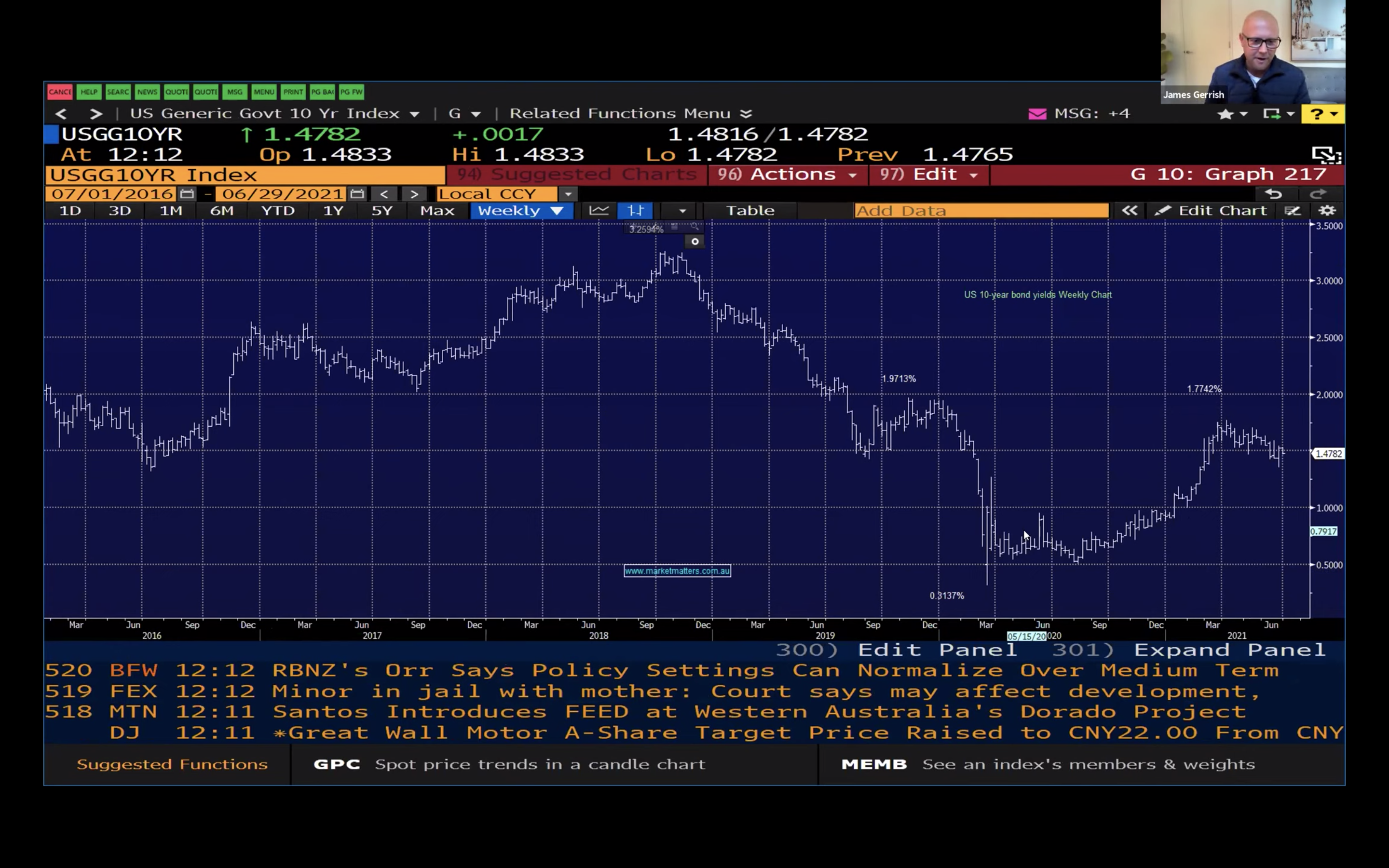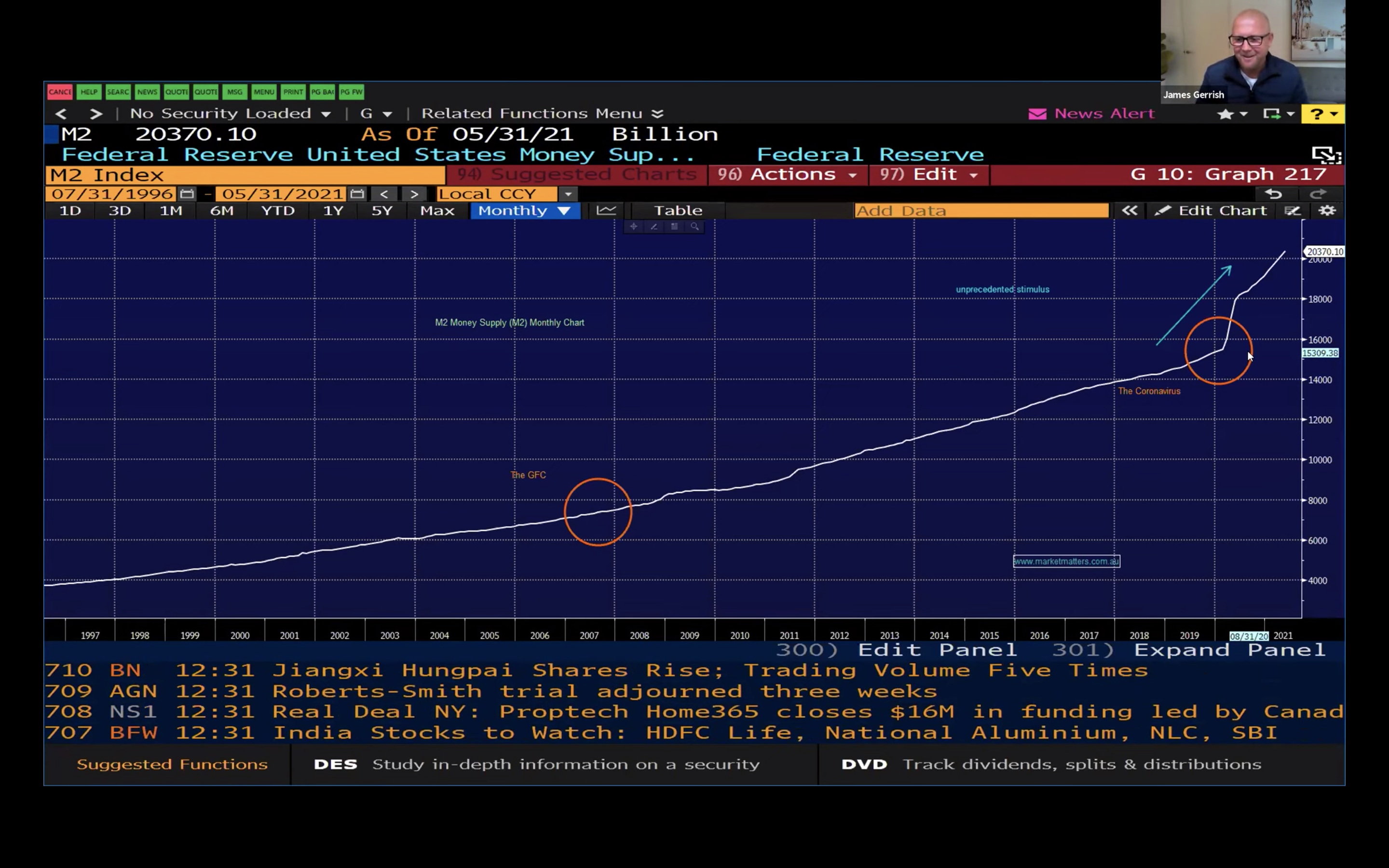Livewire Webinar: What you should look out for in EOFY stock sales

Livewire Markets
With EOFY comes sales, parties and, of course, tax returns. It also presents an opportunity to reflect on the year to date and reassess the composition of your portfolio. That was very much on the mind of those attending a webinar I recently co-hosted with James Gerrish, Portfolio Manager at Market Matters.
What I learnt is that there are few as optimistic as Gerrish. When posed the question as to whether it's time to get defensive and load up on staples he replied "now is not the time to be cautious."
He attributes his bullish attitude to strong earnings growth internationally, the amount of money in the market and strong economic support from central banks.
In my extensive chat with Gerrish, we chatted about the disconnect between bond yields and rates and why that creates a breeding ground for growth companies, discussed what the end of the financial year means for investors and he provided viewers with a few stocks to keep in the bottom draw.
Finally, we fleshed out the importance of asset allocation, particularly considering the current market, his outlook within an inflation riddled future and the importance of constantly looking forward. See below for the complete session and a transcript of some of the highlights.
Webinar
Filmed on June 29, 2021
Edited transcript:
Could you talk us through your end of financial year checklist? (2:22)

There's a lot of talk about the end of the financial year and what you need to do across your portfolios, and I think you can break it down into a couple of key areas. The way I think about it is at the practical things you need to look at for your portfolio, largely around tax from a high level. This means talking to your accountant.
These might seem pretty straightforward but the next is to look at the accrued capital gains in your portfolio over the last four or five months, potentially offsetting these with some losses. You don't want to be donating more to the ATO than you need to.
The third point is around paying forward costs; after a really strong year in markets it's very rare that you won't have capital gains in your portfolio so you can pay forward costs. I pay forward margin line, interest to get that cost into this financial year. So obviously that's something that investors should consider with their accountant and then seek advice around that. This webinar is all around getting your portfolio into gear and I think asset allocation is a really important thing for that.
What I concentrate on most is around improving the asset allocation process, and then I'd probably highlight the warning is that don't let tax decisions dictate investment decisions. So thinking about performance rather than paying a little bit more tax, et cetera to sell a stock that looks like it's about to decline materially but you don't want to incur the capital gain. So that would be the four-point checklist but again don't get too hugely caught up on the end of financial year. I think a lot is made of it more than it probably should be.
What would you point out as the key drivers of FY22 that you expect and are you a bull or a bear going into the new financial year? (6:32)
It's probably not new news but I think the trajectory of interest rates are going to be really key going into FY22 so if you think about the market now, we're in Goldilocks territory. You've got really strong economic growth but also low-interest rates. So central banks are really supportive.
What I just want to highlight on this chart is around interest rates. If I think about interest rates you've got to be thinking about bond yields and the biggest most influential number that you look at is what's happening in the US 10 year bond yield (Figure 2). Obviously, we've had a really low point in bonds, so the US 10 year bond yield dropped down to around 0.3% which is a historically low level. We're now at 1.47% - a big rally from incredibly low levels. We've peaked at about 1.77 and we've come back from there.

So, when I talk about bond yields and interest rates, you peg it to what's happening in the US 10-year but also the relationship between the different duration of bonds. Interest rates are the number one focus, number two being the COVID situation.
I look at global earnings and they are incredibly strong here and that's why I'm remaining bullish on the market.
Earnings for global companies dropped from about $4.2 trillion down to about $3.2 trillion in 2020 during COVID, and they're now back up to $5.1 trillion. So we've had growth in global earnings of about 56% on a consensus basis this year. If I tie that back into the ASX200, the trough in EPS for the index was 250 and that was down from a prior peak of about 345. We're now back up to 355. What I'm saying is the recovery is real, it's being supported by earnings so the market where it is now obviously we're having a bit of a soft session today but the market where it is around 7250 I think is warranted.
When inflation starts to pick up a lot of people turn to gold as a hedge. Are you bullish gold? (13:29)
We have gold in the portfolio. We own a reasonable position in Newcrest; recent weakness has not been good so I'm a little bit 50-50 right here on gold. I think it is a legitimate hedge against inflation. I think in the short term - what the US dollar is doing is probably more important for the gold trade. Right now I think the US dollar is mid-range. My view is that if it goes and tests that 94 region, then the gold prices have a further downside in the near term.
Summing up my view, yes I think it's a hedge against inflation but I think in the near term, it looks average. So I think it will be lower in the near term but over time, it'll rise as those inflationary fears right now evolve. Everyone thinks inflation is very transitory and we're seeing that by the reduction in longer-dated bond yields, but I think that will evolve over time.
I think gold will be lower in the short term but in the medium to longer term is fine. When you're thinking about gold, I think it will trade higher as inflation does pick up.
Can you give us some examples of a high-growth stock that stands out to you? (21:14)
If I look at our portfolio holdings, we've obviously got positions that are underwater but we're up on most stocks. The portfolio is up around 30% this financial year and we have around seven growth positions in our growth portfolio, out of 17. That's about 20% of our capital at the moment but it's about 40% of our positions. Altium is probably an easy one to talk about because that's under takeover.
It's done nicely for us. We did a podcast just before it got taken over but that's when we bought, around the $36 mark.I think that is a stock that speaks to everything we like about growth. The fact that Autodesk came and gave Altium a really bullish bid, they bid them 40% above where the stock price was trading at, and the fact that they rebuffed that bid so quickly shows embedded value in that long-term sense is really key. So to me that there's a very high chance of another bid coming for Altium, so that's a stock that we hold.
_11.png)
We also hold Megaport in the portfolio which has rallied 65% in the last three months. Shorts have gone from 8% to 6% as they've started to show better growth numbers. At the end of the day with growth stocks, you've got to have a really close handle on what the stock is doing and what the market cares about on that stock because the market cares about different things on different stocks.
In the case of Megaport, they dropped near $10 because their growth rates were slowing but as soon as they showed growth in ports and reoccurring revenue then that stock had a really a strong rally at 65%, amplified by the amount of shorts that are out there.
There's been a lot of talk about a potential correction on the horizon. As we enter the new financial year, is this time for investors to become a little bit defensive and perhaps put a few more staple stocks into their portfolio? (25:55)
Is now time to be cautious? I don't think so. The economy is accelerating and that's feeding down into really strong earnings. I will focus on the money supply, the amount of money that's moving around the system as seen in the chart below. Looking at the GFC, the increase in money supply was in the system relative to what we've seen in COVID, where there's been an unprecedented level of new money put in the system, rates are low. The economic backdrop is really supportive.

I don't think it's time to be defensive, but am I cautious towards the market? Yes. I think there's risks out there but what concerns me is complacency. I think that's what from an investor standpoint, you should be concerned about. It's the adage of the bus that you don't see being the one that kills you.
It's not the risks that we see in the markets at the moment that we should be concerned about, I'm concerned about interest rates but we keep the handle on that because we can see it every day. The virus morphing into different strains, that's probably something we can't see as easily every day. So that points to more of a risk for me.
The way of approaching defensiveness is in my view is around having the right asset allocation structure, not just stocks but I'm sure we can talk defensive stocks because there's plenty out there in the market.
Do you have an example of a defensive stock that's in the portfolio now that you think you could explain to us why you think that's defensive? (27:56)
I'm a bull but we've simply got to be playing what's in front of us. Right now I think that all of the indicators are positive. The market is where it should be, earnings are above where they were before, the markets are above where it was but then interest rates are lower and liquidity is higher. I guess that's why I'm more bullish going into FY22, but again I'll be playing eyes-up-footy every day, looking at catalysts that may tweak that view.
In terms of defensive stocks, one focus is Metcash. If I'm thinking about a defensive position I think about a few different things.
Defensives should be not overly cyclical in nature in terms of their earnings, they should be consistent and well-known and not at the vagary of commodity prices or winning large contracts or delivering on a piece of infrastructure or something along those lines.
I think that's a staple, which is why the supermarkets are such staples in portfolios and they're considered a defensive part of investors' portfolios.
The other part of being a defensive stock is around not being overly expensive, because really expensive defensives in the environment that we're going into in FY22, where inflation could really kick. It might not be transitory and that may force the central banks globally to raise interest rates quicker than they ordinarily would and that will have a bigger negative impact on high valuation stocks, even if they're defensive.
So to me, Metcash has got a defensive earning stream, it's relatively cheap. It's insulated against a big macro headwind that could transpire in FY22 or further and it pays a good yield along the way. So that provides a baseline of earnings in a portfolio.
I hate being a cliche and I haven't liked Telstra for a long time but I think Telstra is a really defensive earnings stream that's got a lot of tailwinds that are now building in its favour after a prolonged period of having headwinds.
Could you provide us with a case study on a stock that you've recently sold and walk us through the process of why you made the decision to sell and how you went about it? (31:50)
We have recently trimmed Whitehaven Coal. Whitehaven has obviously been a stock that had a chequered history. We actually bought this pretty poorly. We paid $1.78 from memory, added to it at $1.30, and have just trimmed it at $2.05, and we're continuing to hold it for further upside.
The case I'd make here is that you buy and sell a stock for stock-specific reasons. So the reasons that you're selling a stock is going to be different for each stock that you actually sell.
In Whitehaven's case, we bought it because the share price had languished relative to the underlying commodity price, commodity companies with a high degree of certainty track their underlying commodity pretty closely. Whitehaven Coal wasn't doing that because of operational reasons so we bought it because of that disconnect with the commodity price, being cognisant they had operational issues and that's why there was a disconnect. We trimmed that last week or so because they were due to provide an operational update and I think there were risks around that. So we trimmed 2% out of 6% and we're going to let the rest ride.
We've sold CBA or trimmed CBA and NAB out of our portfolio recently. CBA, we trimmed for all the reasons why we've gone harder in technology.
They have had a phenomenal run in price; we bought it below $60 and sold it above $100. The macro backdrop that was driving CBA was the steepening of the yield curve, higher longer-dated bond yields were really positive for it. That changed, it got stretched from a valuation point of view relative to its peers and we wanted to reduce from overweight to banks to underweight. So we trimmed our position in CBA as a result of that, NAB was the same although from a relative valuation standpoint a little bit less obvious than CBA.
Is selling a different process at the end of the financial year and how do you think about it at this time? (35:02)
So it's different for who you're managing money for. So we manage portfolios on a discretionary basis for individual typically high net worth investors and we have the luxury of being able to look at a tax situation and make changes in line with that situation. So yes, in an individual portfolio basis, yes. If I cast my eye over out to the funds that we manage through market matters, then no we are simply making decisions around performance. Our sole focus is around performance. They've got more investors in those by quantum. So we're not making changes based on an individual's circumstances around that, it's a general bucket. So yeah, each case is different but if you're running your own portfolio, like I am mine, I will make decisions at end of the financial year that suits my individual tax position and that's different for everyone.
Other topics discussed:
- The Reflation Trade (10:44)
- Bitcoin and crypto markets as a hedge against inflation (15:00)
- Bond yields and using them to value growth stocks (18:35)
- What does a recent bid for Altium mean for shareholders? (24:12)
- Why they sold Ramsay Healthcare (34:25)
- Exposure to lithium - ASX: ACDC, ASX: ORE (36:42)
- Geopolitical tensions with China (38:20)
- Updates about A2 Milk and EML Payments (40:12)
- Is there a recovery on the horizon for ServiceStream? (43:15)

Don't forget to pop onto marketmatters.com.au, and take your free 14-day trial. Receive daily newsletters direct to your inbox, a comprehensive website that details our views and outlines our portfolios, so take your free trial today at marketmatters.com.au.
4 topics
13 stocks mentioned
1 contributor mentioned

Bella is a Content Editor at Livewire Markets.
Expertise

Bella is a Content Editor at Livewire Markets.
